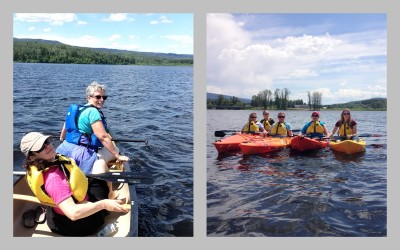Throw Back Thursday: NWBC June 2015 Travel Day Fun
The afternoon of our travel day from Fort St. James to Hazelton found us floating across Burns Lake. My canoe-mates and I lounged and enjoyed the view more than we paddled but the kayakers were more ambitious and explored across the lake and through the reeds. We all equally appreciated a few hours of sun and the sound of water lapping the boats though – after three non-stop days treating the most adorable of patients and then packing the clinic for transport, fun in the sun recharged us to take on Hazelton.

Looking back at Burns Lake
Our team was lucky enough to score the lakeside lunch and time on the water thanks to Alistair and Valerie of the Lakes Animal Friendship Society (www.lakesanimalfriendship.ca). They are great friends of CAAT, having worked with us in the Burns Lake area projects from 2011 to 2014. The annual events during those four years were a huge success with measurable benefits in the reduction of unsterilized animals:
- We vaccinated, dewormed and sterilized over 600 dogs and cats.
- Impoundments in the village of Burns Lake fell to about one-third of previous levels, saving the local taxpayers approximately $8,000 per year in direct costs.
- The number of animals in need of re-homing, which previously were often surrendered to the local rescue group, decreased by 50% from previous levels.
In the lead up to our day in Burns Lake where I finally met the legendary Valerie and Alistair, veteran CAAT members spoke of them with a tone of awe. And sure enough there is good reason for their reputation. Although the 2015 NWBC project moved outside Burns Lake, Valerie and Alistair continued to assist our efforts: from transportation, to introductions to community leaders, to donated dog houses, to local education initiatives that lay the groundwork for CAAT projects, to lunch and fun.
Looking forward to Burns Lake 2016
The Chief of Lake Babine Nation has personally asked CAAT to return to Burns Lake this upcoming June 2016. As the community works to establish local population management programs, they would like CAAT to help them maintain the level of population control achieved during our four years of work there and avoid losing ground as they ramp up their programs. We couldn’t be more excited about this partnered approach for continued long-term success.
